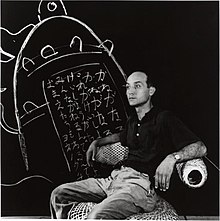Isamu Noguchi
Isamu Noguchi ( Japanese 野 口 勇 , Noguchi Isamu ; born November 17, 1904 in Los Angeles , † December 30, 1988 in New York ) was an American sculptor and designer with Japanese roots.
Live and act

Noguchi's elementary interest in sculptural design made him switch between working as a designer (for Hans Knoll, among others ) and as a sculptor, set designer and landscape architect. His works show the influence of Western art as well as that of Japanese and Chinese traditions.
Born as the son of the Japanese poet Noguchi Yonejirō and the American writer Leonie Gilmour , he studied from 1923 to 1926 at Columbia University and at the Leonardo da Vinci Art School; In 1927 he received the Guggenheim scholarship for two years . From March 1927 he was assistant to Constantin Brâncuși in Paris, who made him familiar with wood and stone reliefs. When the scholarship ended, Noguchi returned to New York in 1929. In the same year his first solo exhibition was shown at the Eugene Schoen Gallery in New York. Between 1930 and 1932 Noguchi made trips to Paris, Beijing and Japan; in China he studied in particular brush drawing, in Japan working with clay with the potter Uno Jinmatsu.
Between 1933 and 1937, Noguchi developed designs for public spaces, monuments, playgrounds and stage sets; In the years from 1942 to 1948 he intensified his work at the theater, while also designing and producing furniture and lamps. After 1949 he traveled various times through Europe, the Middle East and Japan; while traveling he produced drawings and photographs. He built a studio in Kamakura , Japan. He traveled continuously between Japan and New York in the 1950s and set up a studio in Long Island City, New York, in 1961. From 1971 to 1979 he had another studio on the Japanese island of Shikoku .
In 1980 he founded the Isamu Noguchi Foundation, Inc .; 1981 to 1985 the establishment of the Isamu Noguchi Garden Museum in Long Island City, New York.
Another Isamu Noguchi Garden Museum is located in the suburbs of Takamatsu , Japan. This was originally Noguchi's studio, which he set up in 1969 because he liked the granite of the area. Important works were created there. The museum is only open to a limited extent, advance booking is essential.
honors and awards
In 1962 Noguchi was elected to the American Academy of Arts and Letters and 1971 to the American Academy of Arts and Sciences , 1983 in New York as an Associate Member ( ANA ) of the National Academy of Design . In 1984 Noguchi received an honorary doctorate from Columbia University , in 1986 the Kyoto Prize , and in 1987 the National Medal of Arts from the President of the USA. In 1988 he received the Order of the Sacred Treasure, Third Class .
Exhibitions
Isamu Noguchi was a participant in documenta II (1959) and documenta III (1964) in Kassel . In 1986, he represented the United States at the Biennale in Venice .
plant
Only a few sculptors of the early twentieth century succeeded before Land Art in expanding the concept of sculpture in such a way that the landscape was no longer a background, but an actual object of artistic creation. Isamu Noguchi, one of the most important sculptors in the USA, is undoubtedly one of these trend-setting pioneers. His strict, minimalist sculptures, gardens and urban squares are, in their clarity, simplicity and timeless beauty, undisputed models for many contemporary landscape architects and artists of a contemporary approach to landscape and garden as spatial works of art. One would in no way do justice to Noguchi's oeuvre if one regarded his work only as Japanese art in the West. “My father, Yone Noguchi, is Japanese and his poetry has long been known as the translation of the east for the west. I want to do the same with sculpture, ”wrote Noguchi in his 1927 application for a Guggenheim grant .
In addition to his countless sculptures, furniture and lamp creations, Isamu Noguchi's most important works include the following:
- Undine (Nadja) (1927)
- Two bridges for the Peace Park in Hiroshima (1951–1952)
- Gardens for the Connecticut General Life Insurance Company (1956–1957)
- Garden for UNESCO in Paris (1956–1958)
- Billy Rose Sculpture Garden, Israel Museum, Jerusalem (1960–1965)
- Twin sculpture , Munich (1972)
- Bayfront Park in Miami, Florida (1978)
- California Scenario in Costa Mesa, California (1980.1982)
- Domon Ken Museum Garden, Sakata, Japan (1984)
- Moere-Ken Park in Sapporo , Japan (1988)
literature
- Isamu Noguchi - Sculptural Design, ISBN 3-931936-33-3
- Valerie Fletcher (Editor): Isamu Noguchi: Master Sculptor. Scala Publishers 2004 (English) ISBN 1-85759-342-1
- Udo Weilacher: Isamu Noguchi: Space as Sculpture . In: Udo Weilacher: Between Landscape Architecture and Land Art. Basel Berlin Boston 1999, pp. 43–54, ISBN 3-7643-6120-4
- Hayden Herrera: Listening to Stone: The Art and Life of Isamu Noguchi. Farrar, Straus & Giroux, New York 2015, ISBN 978-0-374-28116-8 . ( Reviewed in: The New York Times, June 25, 2015 )
Web links
- The Noguchi Museum (English)
- Materials by and about Isamu Noguchi in the documenta archive
Individual evidence
- ↑ Members: Isamu Noguchi. American Academy of Arts and Letters, accessed April 17, 2019 .
- ↑ nationalacademy.org: Past Academicians "N" / Noguchi, Isamu ANA 1983 ( Memento from January 16, 2014 in the Internet Archive ) (accessed on July 6, 2015)
- ↑ L'Harmattan website (in French)
- ↑ Michael Brenson: Isamu Noguchi, the Sculptor, Dies at 84 , New York Times, December 31, 1988
| personal data | |
|---|---|
| SURNAME | Noguchi, Isamu |
| ALTERNATIVE NAMES | 野 口 勇 (Japanese) |
| BRIEF DESCRIPTION | Japanese-American sculptor |
| DATE OF BIRTH | 17th November 1904 |
| PLACE OF BIRTH | los Angeles |
| DATE OF DEATH | December 30, 1988 |
| Place of death | New York City |

